BepiColombo
| Mission type | Planetary science |
|---|---|
| Operator | ESA · JAXA |
| Website |
at ESA.int at JAXA.jp at ISAS |
| Mission duration | >1 year science phase |
| Spacecraft properties | |
| Manufacturer | EADS Astrium and ISAS |
| Launch mass | 4,100 kg (9,000 lb)[1] |
| BOL mass |
MPO:1,150 kg (2,540 lb)[1] MMO:275 kg (606 lb)[1] |
| Power |
MPO:150 W MMO:90 W |
| Start of mission | |
| Launch date | April 2018 (planned)[2] |
| Rocket | Ariane 5 ECA |
| Launch site | Guiana Space Center[3] |
| Orbital parameters | |
| Reference system | Hermiocentric |
| Flyby of Earth | |
| Flyby of Venus | |
| Flyby of Mercury | |
| Mercury orbiter | |
| Spacecraft component | MMO |
| Orbital insertion | 18 December 2024 (planned) |
| Orbit parameters | |
| Perihermion | 400 km (250 mi) |
| Apohermion | 11,824 km (7,347 mi) |
| Inclination | 90° |
| Mercury orbiter | |
| Spacecraft component | MPO |
| Orbital insertion | 27 March 2025 (planned) |
| Orbit parameters | |
| Perihermion | 400 km (250 mi) |
| Apohermion | 1,508 km (937 mi) |
| Inclination | 90° |
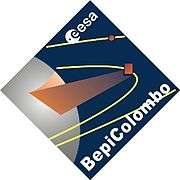 BepiColombo mission logo | |
BepiColombo is a joint mission of the European Space Agency (ESA) and the Japan Aerospace eXploration Agency (JAXA) to the planet Mercury.[4] The mission comprises two satellites to be launched together: the Mercury Planetary Orbiter (MPO) and the Mercury Magnetospheric Orbiter (MMO). The mission will perform a comprehensive study on Mercury, including its magnetic field, magnetosphere, interior structure and surface. It is scheduled to launch in April 2018.[2] The mission was approved in February 2007 as part of the Cosmic Vision programme.[5]
Mission
BepiColombo is named after Giuseppe (Bepi) Colombo (1920–1984), scientist, mathematician and engineer at the University of Padua, Italy, who first implemented the interplanetary gravity-assist maneuver during the 1974 Mariner 10 mission, a technique now commonly used by planetary probes.
The mission involves three components:[6]
- Mercury Transfer Module (MTM) for propulsion, built by ESA
- Mercury Planetary Orbiter (MPO) built by ESA
- Mercury Magnetospheric Orbiter (MMO) built by JAXA.
The prime contractor for ESA is Airbus Defence and Space.[7] ESA is responsible for the overall mission, the design, development assembly and test of the propulsion and MPO modules, and the launch. The two orbiters are planned to be launched together on an Ariane 5 launch vehicle in April 2018. The spacecraft will have a six-year interplanetary cruise to Mercury using solar-electric propulsion (ion thrusters) and gravity assists from Earth, Venus and eventual gravity capture at Mercury.[1] ESA's Cebreros 35-metre ground station is planned to be the primary ground facility for communications during all mission phases.
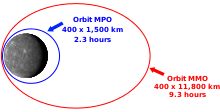
Arriving in Mercury orbit on 18 December 2024, MMO and MPO satellites will then separate and observe Mercury in collaboration for 1 year, with a possible 1-year extension.[1] The orbiters will be equipped with scientific instruments provided by various European countries and Japan. It will characterise the huge liquid iron core (¾ of the planet radius) and will complete gravity and magnetic field mappings. Russia will provide a gamma ray and neutron spectrometers to verify the existence of water ice in polar craters that are permanently in shadow from the Sun's rays.
Mercury is too small and hot for its gravity to retain any significant atmosphere over long periods of time; it does have a "tenuous surface-bounded exosphere"[8] containing hydrogen, helium, oxygen, sodium, calcium, potassium and others. Its exosphere is not stable; atoms are continuously lost and replenished from a variety of sources, and the mission will also study its composition and dynamics, including generation and disappearance.
Objectives
The main objectives of the mission are:[1][3]
- Study the origin and evolution of a planet close to its parent star
- Study Mercury as a planet - its form, interior, structure, geology, composition and craters
- Investigate Mercury's exosphere, composition and dynamics, including generation and disappearance
- Study Mercury's magnetised envelope (magnetosphere) - structure and dynamics
- Investigate the origin of Mercury's magnetic field
- Verify Einstein's theory of general relativity by measuring the parameters gamma and beta of the parameterized post-Newtonian formalism with high accuracy.[9]
Mission design
The spacecraft will have a 7-year interplanetary cruise to Mercury using solar-electric propulsion and eight gravity assists, flying past the Earth and Moon in July 2018, Venus in 2019 and 2020, and five Mercury flybys between 2020 and 2023.[10]
The spacecraft will leave the Earth with an hyperbolic excess velocity of 3.475 km/s. After two years, it returns to Earth to perform a gravity-assist manoeuvre and is deflected towards Venus. Two consecutive Venus flybys reduce the perihelion to Mercury distance with almost no need for thrust. A sequence of five Mercury flybys will lower the relative velocity to 1.76 km/s. Four final thrust arcs further reduce the relative velocity to the point where Mercury will capture the spacecraft on 18 December 2024 into polar orbit; the spacecraft then will be lowered using chemical thrusters.[10][11]
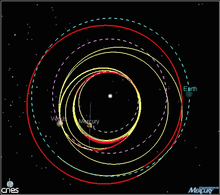
The planned mission schedule is:[1]
| Date | Event | |
|---|---|---|
| April 2018[2] | Launch | |
| 25 July 2019 | 1st Venus flyby | |
| 20 May 2020 | 2nd Venus flyby | |
| 9 April 2021 | 1st Mercury flyby | |
| 27 March 2022 | 2nd Mercury flyby | |
| 16 December 2023 | 3rd Mercury flyby | |
| 24 January 2024 | 4th Mercury flyby | |
| 18 December 2024 | Mercury orbit insertion | |
| 27 March 2025 | MPO in final science orbit | |
| 1 May 2026 | end of nominal mission | |
| 1 May 2027 | end of extended mission | |
Components
Propulsion: Mercury Transfer Module (MTM)
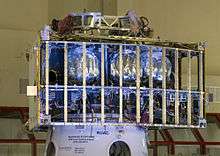
The Mercury Transfer Module is at the base of the 'stack' and provides propulsion for Earth-Mercury transfer and to slow down its approach to Mercury. It carries no significant scientific instruments.
The Transfer Module is equipped with two propulsion systems: a solar electric ion drive engine and a standard chemical propulsion system which is bipropellant using MMH/MON3. The chemical propulsion system will be used for Earth escape and then it will be pyrotechnically isolated, and the solar electric ion engine will take over for the cruise phase. The twin 'QinetiQ T6' ion thrusters operate at maximum combined throttle of 290 mN.[12] The MTM supplies electrical power for the two hibernating orbiters, as well as for its solar electric propulsion system.[13]
The solar electric propulsion will be used for the cruise phase. The ion drives have very high specific impulse and very low thrust. This leads to a flight profile with long continuous low thrust braking to gradually reduce the velocity of the spacecraft. Moments before Mercury orbit insertion, the MTM will be jettisoned from the spacecraft stack.[13]
Mercury Planetary Orbiter (MPO)
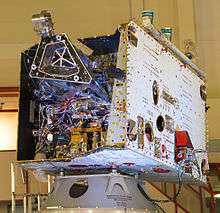
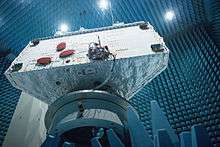
The Mercury Planetary Orbiter will have a mass of 1,150 kilograms (2,540 lb) and will have its sides covered with solar cells providing 150 W at perihelion. A radiator with an area of 1.5 m2 is mounted on one side to provide thermal control. The radiator is always pointed away from the Sun and is protected from planetary IR heat with a 3.4 m2 shield. High efficiency insulation is also used. The configuration and thermal design will provide a stable temperature for internally mounted instruments.
A high-temperature resistant 1.0 m diameter high-gain antenna is mounted on a short boom on the zenith side of the spacecraft. Communications will be on the X and Ka band with an average bit rate of 50 kbit/s and a total data volume of 1550 Gb/year. After the arrival, the MMO will be separated by spin-ejection, will be 3-axis stabilized and nadir pointing. Navigation is facilitated by 3 star sensors. After its release in Mercury orbit, the MPO will be operated by Sagamihara Space Operation Center using Usuda Deep Space Center's 64 m antenna located in Nagano, Japan.[14]
Scientific payload
The scientific payload in the Mercury Planetary Orbiter consist of eleven instruments:[14][15]
- BELA — BepiColombo Laser Altimeter, developed by Switzerland and Germany
- ISA — Italian Spring Accelerometer, developed by Italy
- MERMAG — Mercury Magnetometer, developed by Germany and UK
- MERTIS-TIS — Mercury Thermal Infrared Spectrometer, developed by Germany
- MGNS — Mercury Gamma ray and Neutron Spectrometer, developed by Russia
- MIXS — Mercury Imaging X-ray Spectrometer, developed by UK and Finland
- MORE — Mercury Orbiter Radio science Experiment, developed by Italy and USA
- PHEBUS — Probing of Hermean Exosphere by Ultraviolet Spectroscopy, developed by France and Russia
- SERENA — Search for Exosphere Refilling and Emitted Neutral Abundances (Neutral and ionised particle analyser), developed by Italy, Sweden, Austria and USA
- SIMBIO-SYS — Spectrometers and Imagers for MPO BepiColombo Integrated Observatory System (High resolution and stereo cameras, visual and near infrared spectrometer), developed by Italy, France and Switzerland
- SIXS — Solar Intensity X-ray Spectrometer, developed by Finland and UK
Mercury Magnetospheric Orbiter (MMO)
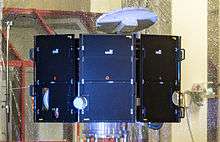
The Mercury Magnetospheric Orbiter has the shape of a short octagonal cylinder, 180 cm long from face to face and 90 cm high.[3][16] It has a total mass of 285 kg (628 lb), including a 45 kg scientific payload.[3][17]
The MMO is spin stabilized at 15 rpm with the spin axis perpendicular to the equator of Mercury and it will enter polar orbit at an altitude of 400 km × 12,000 km - outside the MPO's.[17] The top and bottom of the octagon act as radiators with louvers for active temperature control. The sides are covered with solar cells which provide 90 W. Communications with Earth will be through a 0.8 m diameter X band phased array high-gain antenna and two medium-gain antennas operating in the X band. Telemetry will return 160 Gb/year, about 5 kbit/s over the lifetime of the spacecraft, which is expected to be greater than one year. The reaction and control system is based on cold gas thrusters.
Scientific payload
The Mercury Magnetospheric Orbiter (MMO), being developed and built mostly by Japan, will carry five groups of instruments with a total scientific payload mass of 40 kg:[3][14]
- MPPE — Mercury Plasma Particle Experiment, studies the plasma & neutral particles from the planet, magnetosphere, and interplanetary solar wind. It will employ these instruments:
- Mercury Electron Analyzer (MEA)
- Mercury Ion Analyzer (MIA)
- Mass Spectrum Analyzer (MSA)
- High-Energy Ions (HEP-ion)
- High-Energy Electrons (HEP-ele)
- Energetic Neutrals Analyzer (ENA)
- MGF — Magnetic Field Investigation, studies Mercury's magnetic field, magnetosphere, and interplanetary solar wind.
- PWI — Plasma Wave Investigation, studies the electric field, electromagnetic waves, and radio waves from the magnetosphere and solar wind
- MSASI — Mercury Sodium Atmosphere Spectral Imager, studies the thin sodium atmosphere of Mercury
- MDM — Mercury Dust Monitor, studies dust from the planet and interplanetary space
Mercury Surface Element
The Mercury Surface Element (MSE) was cancelled in 2003 due to budgetary constraints.[5] At the time of cancellation, MSE was meant to be a small (44 kg) lander designed to operate for about one week on the surface of Mercury.[18] Shaped as a 0.9 m diameter disc, it was designed to land at a latitude of 85° near the terminator region. Braking maneuvers would bring the lander to zero velocity at an altitude of 120 metres at which point the propulsion unit would be ejected, the airbags inflated, and the module would fall to the surface with a maximum impact velocity of 30 m/s. Scientific data would be stored onboard and relayed via a cross-dipole UHF antenna to either the MPO or MMO. The MSE would have carried a 7 kg payload consisting of an imaging system (a descent camera and a surface camera), a heat flow and physical properties package, an alpha particle X-ray spectrometer, a magnetometer, a seismometer, a soil penetrating device (mole), and a micro-rover.[19]
See also
References
- 1 2 3 4 5 6 7 "ESA Science & Technology: Fact Sheet". ESA. Retrieved April 5, 2015.
- 1 2 3 "BEPICOLOMBO - Fact Sheet". ESA. 20 April 2016. Retrieved 2016-05-03.
- 1 2 3 4 5 Staff (2008). "MM - BepiColombo". Japan Aerospace Exploration Agency. Retrieved 2014-02-07.
- ↑ Amos, Jonathan (2008-01-18). "European probe aims for Mercury" (web). The European Space Agency (Esa) has signed an industrial contract to build a probe to send to the planet Mercury. BBC News. Retrieved 2008-01-21.
- 1 2 "Europe Scaling Back". NASA News & Events. NASA. 6 November 2003. Retrieved 2014-02-07.
- ↑ Hajime Hayakawa: BepiColombo Mercury Magnetospheric Orbiter (MMO)
- ↑ "BepiColombo To Enter Implementation Phase". ESA. 26 Feb 2007.
- ↑ Domingue DL, Koehn PL, et al. (2009). "Mercury's Atmosphere: A Surface-Bounded Exosphere". Space Science Reviews. 131 (1–4): 161–186. Bibcode:2007SSRv..131..161D. doi:10.1007/s11214-007-9260-9.
- ↑ "BepiColombo - Testing general relativity". ESA. 4 July 2003. Retrieved 2014-02-07.
- 1 2 "NASA Data Center: BepiColombo". 26 August 2014. Retrieved 2015-04-06.
- ↑ Staff. "BepiColombo Mission Operations - Getting to Mercury". ESA. Retrieved 2014-02-07.
- ↑ Clark, Stephen D. (October 6–10, 2013). "BepiColombo Electric Propulsion Thruster and High Power Electronics Coupling Test Performances". 33rd International Electric Propulsion Conference.
- 1 2 Staff (20 October 2011). "Mercury Planetary Orbiter - spacecraft". European Space Agency. Retrieved 2014-02-06.
- 1 2 3 "MMO (Mercury Magnetospheric Orbiter) : Objectives". JAXA. 2011. Retrieved 2014-02-07.
- ↑ Staff (15 January 2008). "The Mercury Planetary Orbiter - Instruments". European Space Agency. Retrieved 2014-02-06.
- ↑ H. Yamakawa; H. Ogawa; Y. Kasaba; H. Hayakawa; T. Mukai; M. Adachi (2004). "Current status of the BepiColombo/MMO spacecraft design". Advances in Space Research. 33 (12): 2133–2141. Bibcode:2004AdSpR..33.2133Y. doi:10.1016/S0273-1177(03)00437-X.
- 1 2 "Mercury Exploration Project "BepiColombo"" (PDF). Japan Aerospace Exploration Agency (JAXA). JAXA. 2014. Retrieved 2015-04-06.
- ↑ "BepiColombo". ESA. NASA. 2004. Retrieved 2014-02-07.
- ↑ "BepiColombo's lander". ESA. 2001. Retrieved 2014-02-07.
External links
- ESA site
- BepiColombo page at ESA Spacecraft Operations
- JAXA site
- ISAS site
- BepiColombo Mission Profile by NASA's Solar System Exploration
- NASA - NSSDC - Spacecraft - Details


.jpg)